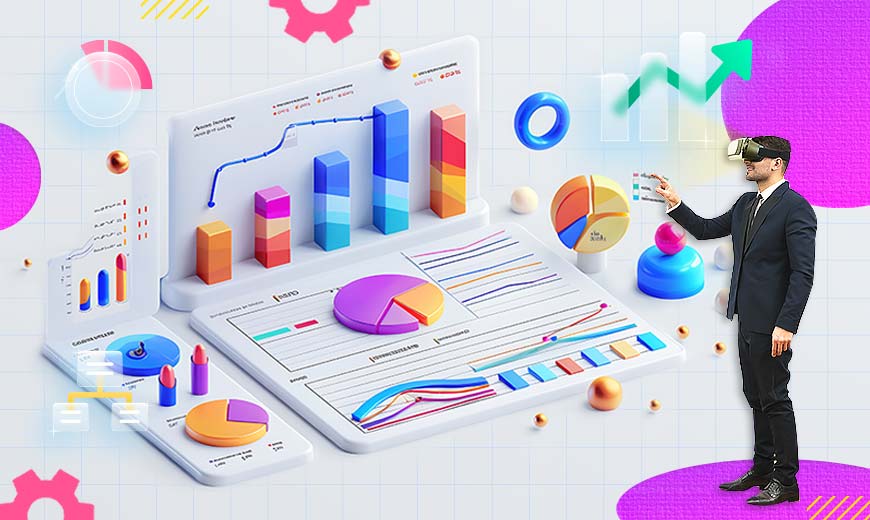Building Dynamic Data Dashboard with Real-Time Data Integration
Dynamic data dashboard with real-time data integration are powerful tools for monitoring and analyzing data as it happens. They provide immediate insights, enabling swift decision-making and efficient operations. Here’s a comprehensive guide on building such dashboards, incorporating key components, building techniques, additional considerations, and real-world applications.
Key Components of a Data Dashboard
Data Sources
Identifying where your data resides is the first step.
Data sources can be:
- Internal Databases: CRM systems, sales data, marketing campaign performance.
- External APIs: Stock market data, social media analytics, weather information.
- Web Scraping Outputs: Product pricing comparisons, competitor website traffic.
Data Preparation
Data preparation involves cleaning, transforming, and aggregating data to ensure clarity and avoid overwhelming viewers.
Common techniques include:
- Handling Missing Values: Filling with averages or removing entries.
- Data Cleaning: Correcting typos, standardizing formats.
- Data Transformation: Calculating ratios, converting units.
- Data Aggregation: Summing by category, averaging over time.
Visualization Tools
Choosing the right platform for displaying your data is crucial.
Consider the following popular options:
- Tableau: Strong user interface, drag-and-drop functionality, extensive customization options (paid).
- Power BI: Seamless integration with Microsoft products, excellent data modeling capabilities (paid).
- Grafana: Real-time focus, customizable dashboards, open-source community support.
- Looker: Cloud-based, focus on business intelligence, embedded analytics (paid).
Building Real-Time Integration in Data Dashboard
Push Technology
Data sources actively push updates to the data dashboard whenever changes occur. This approach requires a robust infrastructure and can be resource-intensive but provides immediate updates.
Pull Technology
The dashboard periodically pulls data from the source at set intervals. This method is simpler to implement but might introduce a slight delay in displaying updates.
Additional Considerations for Your Data Dashboard
User Interaction
Enhance user engagement by allowing users to filter data, drill down into details, and interact with visualizations. Examples include:
- Interactive Filters: Narrow down data views.
- Drill-Down Capabilities: Deep dives into specific data points.
- User-Defined Thresholds: Trigger alerts for critical events.
Alerts and Notifications
Set up alerts to notify users of critical events or trends identified by the real-time data. This ensures immediate attention to important changes.
Security
Ensure proper security measures are in place to protect sensitive data displayed on the dashboard. Compliance with data privacy regulations like GDPR and CCPA is essential.
Getting Started with Data Dashboards
Tutorials and Documentation
Leverage comprehensive tutorials and documentation provided by your chosen visualization tool:
- Tableau: Offers online courses on building real-time dashboards.
- Power BI: Microsoft provides detailed documentation on creating dashboards with live data.
- Grafana: Explore open-source dashboards built for different industries (e.g., finance, IT).
Open-Source Tools
Explore open-source options like Grafana for a cost-effective solution, especially if you’re comfortable with some coding.
Real-World Applications of Data Dashboards
Sales and Marketing
- Customer Engagement: Track website traffic, social media mentions, and campaign performance in real-time.
- Sales Performance: Monitor sales pipeline progress, conversion rates, and identify top-performing sales reps.
- Inventory Management: Gain real-time insights into stock levels and optimize inventory allocation.
Operations and Supply Chain
- Production Monitoring: Track machine performance and address issues before they disrupt operations.
- Logistics and Delivery Tracking: Monitor delivery routes and optimize schedules.
Quality Control: Identify product defects during manufacturing and take corrective actions immediately.
Customer Service
- Customer Sentiment Analysis: Track social media conversations and customer reviews in real-time.
- Agent Performance Monitoring: Monitor call center metrics and identify areas for improvement.
- Live Chat Analytics: Analyze chat conversations to improve knowledge base articles.
Finance and Risk Management
- Market Performance: Track stock prices, currency fluctuations, and market trends.
- Fraud Detection: Monitor transactions for suspicious activity and identify potential fraud attempts.
- Cash Flow Management: Gain real-time insights into cash flow and make informed financial decisions.
Human Resources
- Employee Engagement: Track employee sentiment and identify areas for improvement.
- Project Management: Monitor project progress and identify potential roadblocks.
- Workforce Analytics: Analyze employee performance data to identify top performers and areas for skills development.
Benefits of Real-Time Data Integration
Real-time data integration in dashboards offers several significant benefits compared to traditional dashboards with static data:
- Improved Decision-Making: With up-to-the-minute information, users can react to situations as they unfold.
- Faster Problem Identification: Real-time data helps spot issues quickly before they snowball.
- Enhanced Customer Experience: Real-time data empowers businesses to personalize the customer journey.
- Increased Operational Efficiency: Businesses can optimize resource allocation with a constant view of operations.
- Greater Agility and Adaptability: Monitor market trends and competitor activity to stay ahead of the curve.
- Improved Cost Efficiencies: Save money through preventive actions and optimized resource allocation.
- Stronger Data-Driven Culture: Encourage a data-driven approach to decision-making across all levels of the organization.
Challenges of Real-Time Integration in Data Dashboard
Data Volume and Velocity
Handling the high volume and velocity of incoming data can be overwhelming, leading to delays and bottlenecks.
Data Quality and Consistency
Maintaining data quality is crucial for accurate insights. Real-time data sources are more prone to errors and inconsistencies, making data validation and cleaning processes essential.
Scalability and Performance
Real-time data integration systems need to be scalable to accommodate growing data volumes and user demands without compromising performance.
Security and Compliance
Robust security measures are essential to protect sensitive data from breaches and unauthorized access. Compliance with data privacy regulations adds another layer of complexity.
Complexity of Integration
Connecting multiple data sources with different formats and structures can be challenging. Efficient data pipelines are crucial for seamless integration.
Also Read: Unleashing the Power of Data Insights & Analytics for Business Success
Cost Considerations for Data Dashboard
Investment in infrastructure, tools, and skilled personnel is necessary for managing the data flow and ensuring its quality. Finding a cost-effective solution that meets your needs is important.
Conclusion
Building dynamic data dashboard with real-time data integration can be a rewarding task. By following these steps and leveraging available tools, you can create powerful insights engines for your organization.
Real-time data dashboards transform static reports into dynamic command centers, empowering businesses to react swiftly, optimize operations, and gain a competitive edge.
Define the purpose of your dashboard and the target audience, start simple, and iterate on your design. With real-time data, your organization can make informed decisions, improve performance, and stay ahead in today’s fast-paced business environment.







